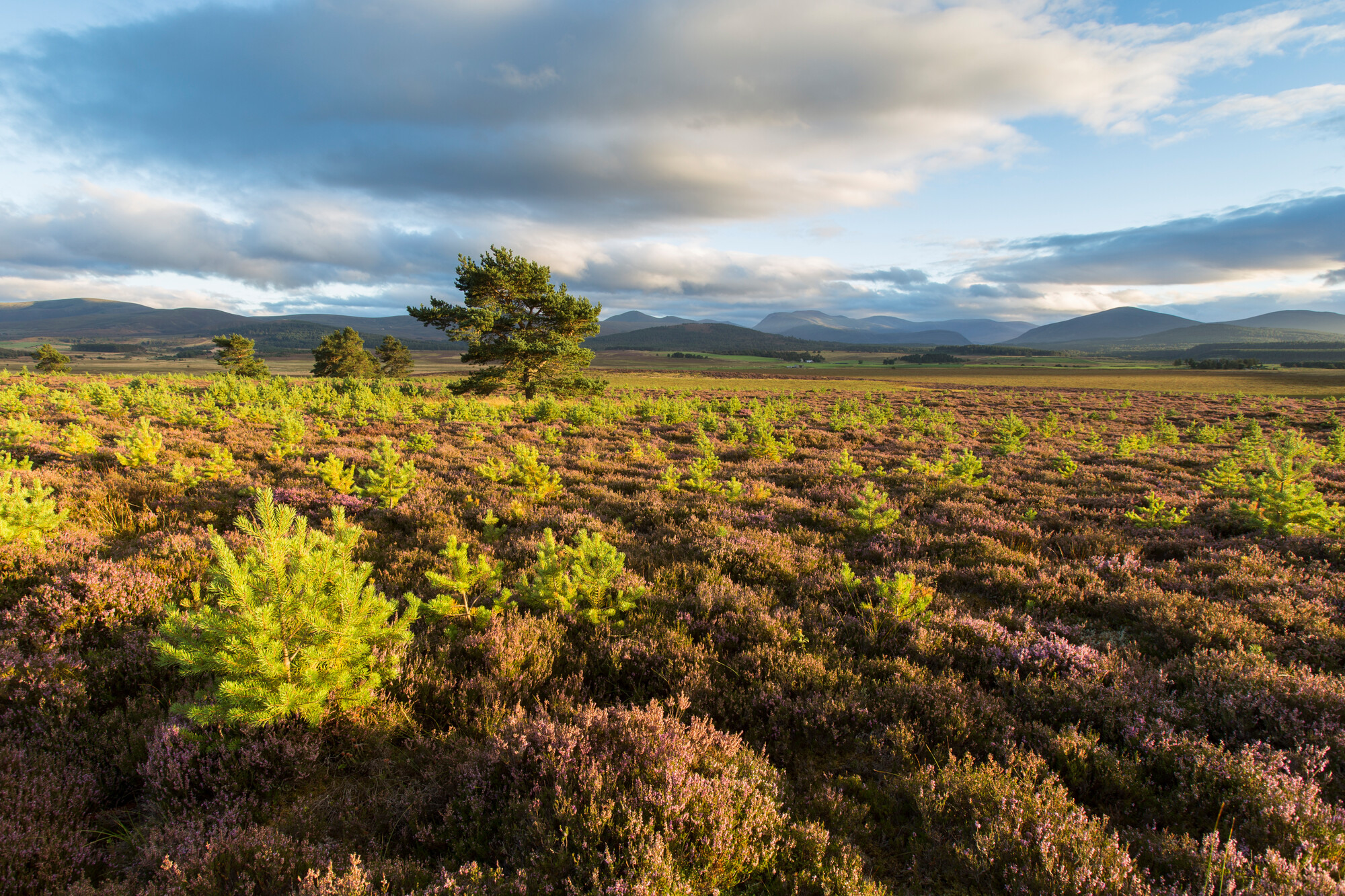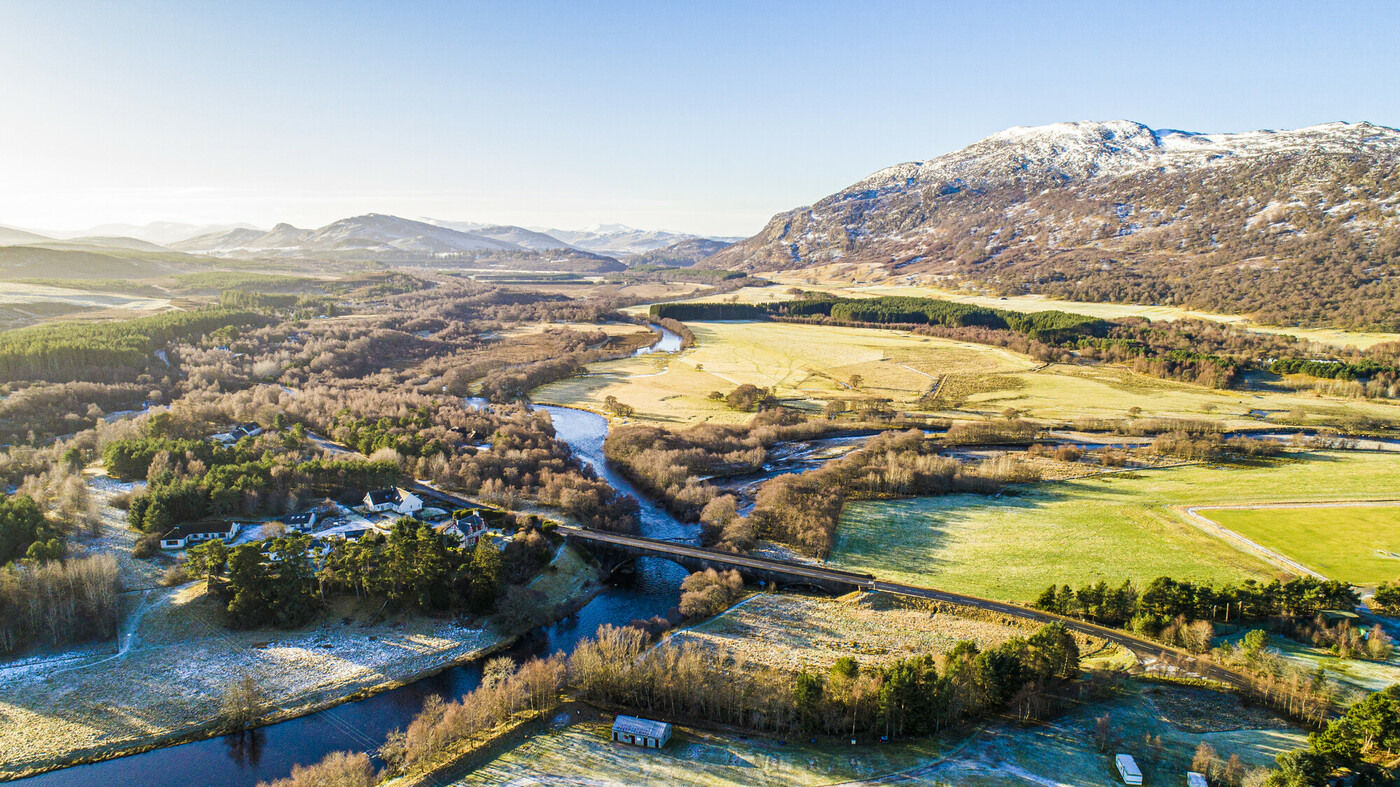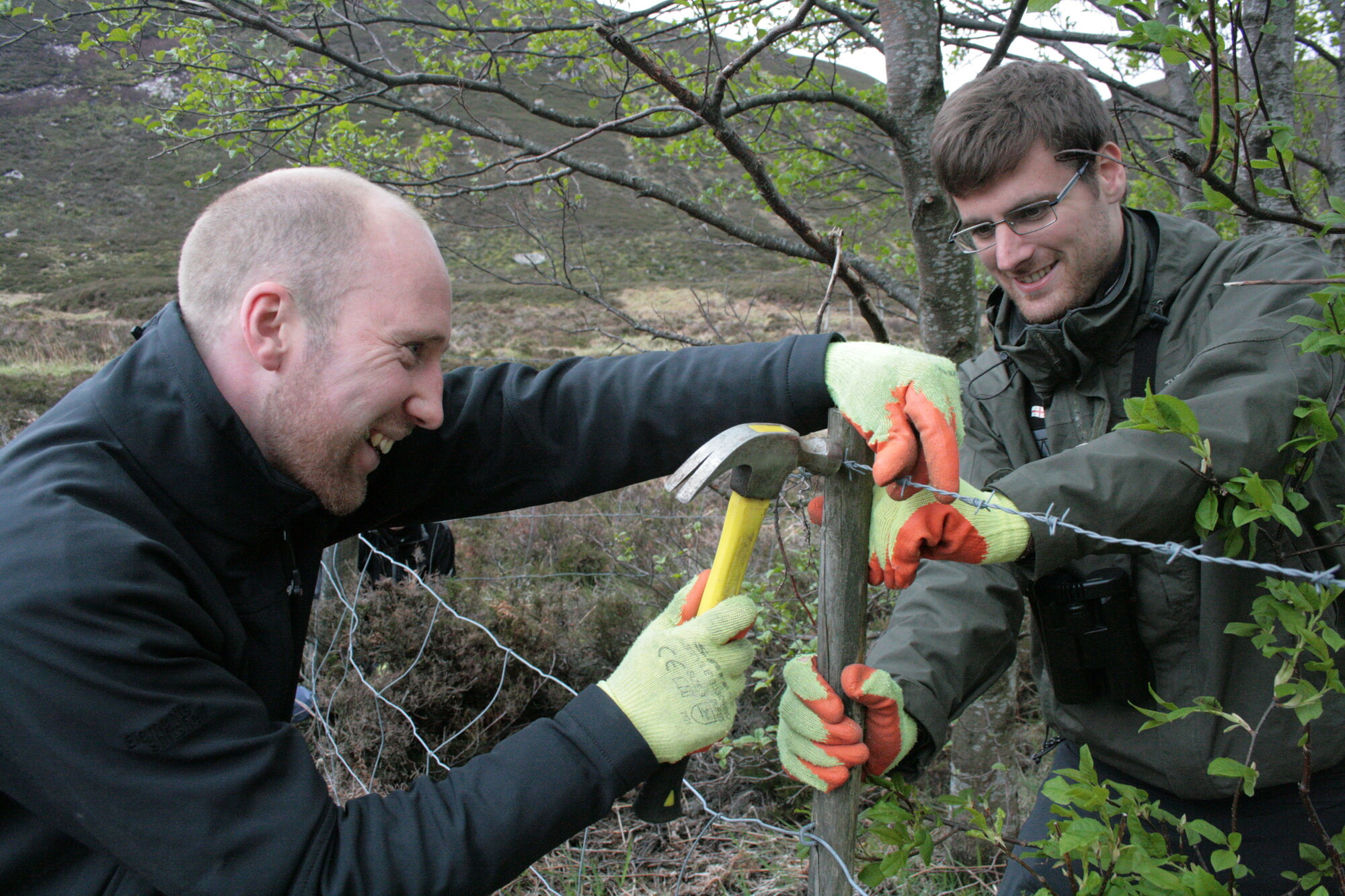River Dee flood risk assessment
Date: 18th July 2023 To: Dr. Sally Mackenzie From: cbec eco engineering UK Ltd Project: River Dee Valley Restoration Subject: Flood Risk Assessment
- INTRODUCTION
cbec eco engineering
1.1 PURPOSE OF STUDY The aim of this project is to undertake a detailed design study for the proposed restoration of a 3.6 km reach of the River Dee, between Allanquoich and Allanmore, west of Braemar. This will involve full or partial embankment removal along the river left bank, re-instating channel-floodplain connectivity and thereby improving the quality of in-stream and floodplain habitats at the landscape scale. The study site can be seen in Figure 2.1.
As part of this study, this flood risk assessment (FRA) has been completed in support of the proposed construction, assessing any flood risk concerns raised by the proposed scheme in accordance with Scottish Planning Policy (SPP).
1.2 SCOPE OF STUDY The assessment is a comprehensive, risk-based assessment of potential flooding from all possible sources, including fluvial flooding from adjacent watercourses, groundwater and surface water runoff. The assessment also identifies and examines the residual flood risk to the site and any neighbouring properties. The aim of this report is primarily to consider flood risk and satisfy requirements under SPP.
Data and information have been obtained from the following sources:
- SEPA; 19/06/2023
- Aberdeenshire Council; 19/06/2023
- North East Local Plan District — Local Flood Risk Management Strategy (LFRMS);
- River Dee Catchment Flood Management Plan (CFMP)
- topographical survey data;
- hydraulic modelling results
River Dee Detailed Design Flood Risk Assessment 20/07/23 1 cbec eco-engineering UK Ltd.
- BACKGROUND INFORMATION
cbec eco engineering
2.1 DEVELOPMENT SITE The development site can be seen in Figure 2 – 1 below:
RIVER DEE VALLEY RESTORATION — LOCATION MAP
Study Reach River Dee Channel Catchment Boundary
RIVER DEE BRAEMAR CRATHIE
cbec eco engineering
BIRKHALL N
2150259 PARK AUTHORITY Date 13 JUN 2023 BRAEMAR CLIENT CAIRNGORMS NATIONAL Project no. PROJECT RIVER DEE VALLEY 0 5 10 km Drawn Designed RESTORATION Reviewed ED GF Scale @ A4‑1:180,000 British National Grid GCS OSGB 1936
Figure 2 – 1 Development site location
The site is rural and situated along the River Dee just west of Braemar within the Cairngorms National Park. The approximate grid reference for the upstream extent is NO 12259 90688 and the downstream is NO 14608 92166. The closest village is Braemar which resides to the south east of the downstream extent of the study area. The Lin of Dee Road runs parallel to the River Dee along the entire study extent.
The study area is situated in a fairly steep valley (an elevation map is shown in Figure 2 – 2) where the bedrock geology of the study area within the channel is predominantly Glen Spean Subgroup Psammite. However, there are small areas of Felsite, Pelite, and Granite sporadically situated within the floodplain. This generally means the catchment is fairly impermeable.
River Dee Detailed Design Flood Risk Assessment 20/07/23 2 cbec eco-engineering UK Ltd.
cbec eco engineering RIVER DEE — EXISTING CONDITIONS DEM SURFACE
A
cbec eco engineering
Surface DEM elevations (m) 345 m 320 m
Figure 2 – 2. Elevation map of study site.
River Dee BRAEMAR ABERDEENSHIRE UNTAINS 0 200 400 600 800 CLIENT CAIRNGORMS NATIONAL Project no. 2150259 PARK AUTHORITY PROJECT RIVER DEE DETAILED DESIGN Date MARCH 2023 Drawn Surveyed FD & GP Reviewed KC Scale @ A4‑1:15,000 British National Grid: GCS OSGB 1936 Service Layer Credits: Contams is data Creen Copyright and database rght 2622 Fathstar fleographics, and the tus User Commandy
2.2 DEVELOPMENT PROPOSALS Partial or full removal of the embankment along the northern bank of the River Dee has been proposed within the study extent. Several restoration options have been considered, as detailed in the accompanying ‘River Restoration Design Report’. A high-level options map for the full embankment removal option is presented in Figure 2 – 3 for context. The final preferred option offers a compromise between partial and full removal, with the majority of the embankment being removed and all hard bank protection on river left removed. Further details regarding the final design are provided in the main project report.
River Dee Detailed Design Flood Risk Assessment 20/07/23 3 cbec eco-engineering UK Ltd.
cbec eco engineering OPTION 3 FULL REMOVAL
Enhance existing higher quality grazing land in conjunction with wetland management Undertake riparian planting selectively along river corridor (locations and extents indicative only and subject to consultation) to provide habitat and a future source of large wood Replace existing plastic dams with nature-based options (e.g. leaky wood dams)
Preserve and enhance existing good wader habitat along floodplain margin
Remove entire embankment to restore channel/floodplain connectivity and restore natural fluvial process throughout entire restoration extent Add large wood to floodplain to enhance geomorphic process and floodplain diversity and provide direct habitat benefits (locations indicative only) Create wader scrapes to enhance floodplain habitat (locations indicative only) Install medial LWS to enhance natural process and habitat evolution Install bar apex LWS to enhance natural processes in the channel and encourage more frequent spill onto floodplain Partial or full infilling of ditches using spoil from embankment removal/scrape creation to retain more standing water along northern margin of floodplain and enhance existing good wader habitat
Retain existing embankment Remove all bank toe protection along river left bank to remove constraints to lateral adjustment Create scrapes in areas of existing low topography Maintain & enhance grazing Retain existing bank protection * In-channel large wood structures Remove embankment Remove bank protection Infill/partially infill ditches Riparian planting Floodplain scrapes Floodplain large wood Existing wetland habitat Develop/enhance woodland/wet woodland Replace plastic dams
Figure 2 – 3. Full embankment removal design proposal.
- STATUTORY CONSULTATION 3.1 SCOTTISH ENVIRONMENT PROTECTION AGENCY (SEPA) SEPA was approached regarding any known local flood risk or historic flooding records in the area, of which they noted 10 of the 12 recorded flood events along the River Dee were related to fluvial flooding. However, these flood events occurred along differing reaches of the River Dee and no information specific to the site is noted.
Full correspondence with SEPA is reported in Appendix A of this Flood Risk Assessment.
3.2 ABERDEENSHIRE COUNCIL Aberdeenshire Council was approached regarding any known local flood risk or historic flooding records in the area.
Full correspondence with the Council is reported in Appendix A of this Flood Risk Assessment.
River Dee Detailed Design Flood Risk Assessment 20/07/23 4 cbec eco-engineering UK Ltd.
cbec eco engineering
- PLANNING POLICY 4.1 NORTH EAST LOCAL PLAN DISTRICT — LOCAL FLOOD RISK MANAGEMENT STRATEGY (LFRMS) The North East Local Plan District LFRMS was prepared and submitted in December 2022. It does not mention any specific issues with the River Dee at Braemar, nor any specific objectives for the catchment beyond attempting to reduce flood risk where possible.
4.2 DEE CATCHMENT FLOOD MANAGEMENT PLAN (CFMP) The Dee Catchment Flood Management Plan was prepared and submitted in November 2007. The proposed development site lies in headwaters of the River Dee, situated within the Cairngorms. Therefore, there is no specific policy unit allocated to this section of the River Dee. The Cairngorms National Park Authority (CNPA) ensure the aims listed below are collectively achieved:
- To conserve and enhance the natural and cultural heritage of the area
- To promote sustainable use of the natural resources
- To promote understanding and enjoyment of the special qualities of the area by the public
- To promote sustainable economic and social development of the area’s communities
The proposed restoration is not designed to specifically reduce flood risk, but is in line with restoring a more natural flow régime and thus satisfies the requirements of this policy.
4.3 SCOTTISH PLANNING POLICY Scottish Planning Policy (SPP) seeks to reduce the impact of flooding on new developments, by expecting developers and planning authorities to err on the side of caution in decision making whenever flooding is an issue. In particular, it requires that no new developments should be built on the functional floodplain, defined as having a greater than 0.5% chance of flooding in any given year. Exceptions may exist where the development location is essential for operational reasons, or cannot be placed elsewhere.
The proposed development lies within the functional floodplain. However, due to the nature of the measures proposed the restoration design cannot be placed in an area of lower flood risk, thus this satisfies the requirements of the SPP.
River Dee Detailed Design Flood Risk Assessment 20/07/23 5 cbec eco-engineering UK Ltd.
- ASSESSMENT OF FLOOD RISK 5.1 FLUVIAL FLOOD RISK
cbec eco engineering
5.1.1. SEPA Flood Risk Map The SEPA flood map, shown in Figure 5 – 1, reveals that the development site is located within the functional floodplain, at high risk of flooding (a 10% chance of occurring each year). The primary source of flooding to the site is fluvial, deriving from the River Dee.
Braenar Auchendryne ee 21:165 Braemar River Flooding High Likelihood Each year this area has a 10% chance of flooding. Medium Likelihood. Each year this area has a 0.5% chance of flooding. sesri Crown copyright and database rights (2022) OS 100016991. Contains OS Data, use subject to OS Terms and Con…
Figure 5 – 1. SEPA flood zone map — [SEPA Flood Maps (arcgis.com)](https://SEPA Flood Maps (arcgis.com)).
5.1.2. Historic flooding There are no current online records available regarding historic flooding along the River Dee. SEPA and Aberdeenshire Council have been contacted and their response is provided in Appendix A.
River Dee Detailed Design Flood Risk Assessment 20/07/23 6 cbec eco-engineering UK Ltd.
cbec eco engineering
5.2 HYDRAULIC MODELLING As part of the design project, hydraulic modelling of the Dee at the site was undertaken by cbec. The stretch of river at the project site was modelled as existing, and then with the proposed design implemented. The pre- and post-design scenarios have been compared, to assess the potential change to flood risk that might occur because of the proposed restoration.
A full discussion of the hydraulic modelling is included in the main project report.
The 1 in 10 year results are shown in Figure 5 – 2, the 1 in 200 year in Figure 5 – 3 and the 1 in 200 year plus 37% climate change in Figure 5 – 4.
The results show the extents of the flooding remains constrained within the valley floodplain, defined by the steep-sided terrain, for all events, with no change between the existing and design scenarios. The maximum depth on the floodplain does increase for the design scenario, which is expected given the nature of the restoration scheme.
There is one property close to the floodplain, Allanmore (see Figure 5 – 5), potentially at risk of flooding. The property itself appears to be on higher ground, outwith the flooded area, but the access road both to the east and west are affected. The risk does not change though in the proposed design case.
There is a barn, owned by Allanquoich Farm, shown in Figure 5 – 6, within the floodplain. This is the case both for the existing and design scenarios, and the risk does not change in the design scenario.
The pass-forward flow hydrographs at the downstream extent of the model were assessed. These demonstrate the flow leaving the project site, and are used to estimate the potential effect on downstream flooding the proposed design might have. The hydrographs are shown in Figure 5 – 7 to Figure 5 – 9. The 200 year and 200 year plus climate change events show negligible difference in the flow hydrographs, suggesting that the design will have no impact on downstream flooding. Figure 5 – 9 suggests this is the case for all events, except the 1 in 2 year, which indicates a slight attenuation in the rising limb of the hydrograph in the design case. The peaks remain the same. This may potentially mean a slight attenuation of the 1 in 2 year event downstream of the site, but the effect is very minor.
River Dee Detailed Design Flood Risk Assessment 20/07/23 7 cbec eco-engineering UK Ltd.
cbec eco engineering RIVER DEE — MODELLING RESULTS — WATER DEPTH — 10Y RETURN PERIOD
Existing Conditions
Water Quoich Cairnre Drochaide Carr Cottage
Design Conditions
Cairnre Drochaide Water Quoich
Water depth (m) Dee Carr Cottage
Dalgowan River Dee
Dalgowan Mill of Coull Greenfeld Linn Of Dee Rd cbec eco engineering Inverchandlick Cottage BRAEMAR Clunie Water Toll Ho Choinnich House N
Inverchandlick Cottage Clunie Water Toll Ho River Dee Mill of Coult ABERDEENSHIRE Strathdon Greenfeld Linn Of Dee Ra BRAEMAR CLIENT CAIRNGORMS NATIONAL PARK AUTHORITY PROJECT RIVER DEE DETAILED DESIGN Corgarf acdul CAIRNGORMS Ballater 0 200 400 600 800 Deeside & Braemar Lochnagar Lochnagar UNTAINS
Project no. Date Drawn Modelled Reviewed N A 2150259 JULY 2023 ال EG KC Scale @ A4‑1:15,000
British National Grid: Service Layer Credits: Contains OS data Crown Copyright and database right 2020 Contains OS dela Crown Copyright and database night 2022 GCS OSGB 1936 Choinnich House 1m‑1.5m 1.5m — 2m Existing embankment Embankment removal Proposed wetland Proposed LWS Cain Germ prm < 0.25m 0.25m 0.50m 0.50m 0.75m 2m — 3m 0.75m-1m
3m
cbec eco-engineering UK Ltd. Figure 5 – 2. Comparison of 1 in 10 year (10% annual chance of occurring) flood results.
River Dee Detailed Design Flood Risk Assessment 20/07/23 8
cbec eco engineering RIVER DEE — MODELLING RESULTS — WATER DEPTH — 200Y RETURN PERIOD
Existing Conditions
Water Quoich Design Conditions
Water Quoich Cairnra Dr Alanaquocth Carr Cottag Alana anquoch Cairnra Droshade Dee Carr Cottage
Dalgowan River Dee
Dalgowan cbec eco engineering Invarchandlick Cottage Mill of Cout! Greenfielt Linn Of Dee Ra BRAEMAR Clunie Water Toll Ho Choinnich House AGR N
Inverchandiick Cottage Clunie Water Toll Ho River Dee Mill of Coull ABERDEENSHIRE Strathdon Cain Gart CAIRNGORMS Des Greenfield Linn Of Dee Rd BRAEMAR CLIENT CAIRNGORMS NATIONAL PARK AUTHORITY PROJECT RIVER DEE DETAILED DESIGN Ballator 0 200 400 600 800 Service Layer Credits. Contains OS data Crown Copyright and database right 2020 Contains OS data Crown Copyright and database right 2022 Choinnich House Project no. Date Drawn Modelled Reviewed A N A 2150259 JULY 2023 ال EG KC Scale @ A4‑1:15,000 British National Grid: GCS OSGB 1936 Water depth (m) < 0.25m 0.25m 0.50m 1m‑1.5m 1.5m — 2m 0.50m 0.75m 2m — 3m 0.75m — 1m
3m Existing embankment Embankment removal Proposed wetland Proposed LWS
cbec eco-engineering UK Ltd. Figure 5 – 3. Comparison of 1 in 200 year (0.5% annual chance of occurring) flood results.
River Dee Detailed Design Flood Risk Assessment 20/07/23 9
cbec eco engineering RIVER DEE — MODELLING RESULTS — WATER DEPTH — 200Y RETURN PERIOD + CLIMATE CHANGE
Existing Conditions
Cairnra Dy Allanaqu cbec eco engineering Invarchandlick Cottage Water Quoich Design Conditions
Water Quoich Water depth (m) < 0.25m Allanaquech arr Cottage Cairnra Dreshakde 1m — 1.5m Dee 0.25m 0.50m 1.5m — 2m 0.50m 0.75m 2m — 3m 0.75m — 1m
3m Carr Cottage
Dee Dalgowan River Dee Mill of Coull Greenfield Clunie Water Toll Hot Choinnich House N Linn Of Dee Ra Inverchandlick Cottage Clunie Water Toll Hot Choinnich House A99 N
Dalgowan River Dee Mill of Coull ABERDEENSHIRE Strathdon Cabn Corgarf Greenfield Linn Of Dee Ra BRAEMAR CLIENT CAIRNGORMS NATIONAL PARK AUTHORITY PROJECT RIVER DEE DETAILED DESIGN 400 600 800 CAIRNGORMS Ballater 0 200 Deeside & Dee Braemar Lochnagar A Lechmagar NTAINS Project no. Date Drawn Modelled Reviewed 2150259 JULY 2023 ال EG KC Scale @ A4‑1:15,000
British National Grid: GCS OSGB 1936 Existing embankment Embankment removal Proposed wetland Proposed LWS
Figure 5 – 4. Comparison of 1 in 200 year (0.5% annual chance of occurring) plus 37% climate change flood results.
River Dee Detailed Design Flood Risk Assessment 20/07/23 10 cbec eco-engineering UK Ltd.
Figure 5 – 5. Allanmore property, close to the floodplain.
cbec eco engineering
River Dee River Dee Detailed Design Flood Risk Assessment 20/07/23 11 cbec eco-engineering UK Ltd.
River Quoich Figure 5 – 6. Allanquoich Farm barn, situated within the floodplain.
Pass forward discharge [m³/s] 600.00 500.00 400.00 300.00 200.00 100.00 0.00 4 9 14 19 24 29 Time [h] EC 200Y DE 200Y
Figure 5 – 7. Pass-forward flow hydrographs for existing and design cases, for the 1 in 200 year event.
River Dee Detailed Design Flood Risk Assessment 20/07/23 12 cbec eco-engineering UK Ltd. cbec eco engineering
Pass forward discharge [m³/s] 800.00 700.00 600.00 500.00 400.00 300.00 200.00 100.00 0.00 4 9 14 19 24 29 Time [h] 600.00 EC 200Y+37% DE 200Y+37%
Figure 5 – 8. Pass-forward flow hydrographs for existing and design cases, for the 1 in 200 year plus 37% climate change event.
Pass forward discharge [m³/s] EC 2Y 500.00 DE 2Y EC 5Y 400.00 DE 5Y EC 10Y 300.00 DE 10Y EC 30Y 200.00 DE 30Y 100.00 EC 50Y DE 50Y 0.00 EC 100Y 3 8 13 18 23 28 DE 100Y Time [h]
Figure 5 – 9. Comparison of pass-forward flow hydrographs for all events.
River Dee Detailed Design Flood Risk Assessment 20/07/23 13 cbec eco-engineering UK Ltd. cbec eco engineering
5.3 SURFACE WATER FLOOD RISK
cbec eco engineering
5.3.1. Surface water flood risk to the scheme While the primary source of flooding to the proposed scheme is fluvial, Figure 5 – 10 highlights the risk of surface water flooding to the site.
River Dee River Dee Braemar Auchendryne Braemar River Dee Surface Water Flooding High Likelihood Each year this area has a 10% chance of flooding. Medium Likelihood Each year this area has a 0.5% chance of flooding. Low Likelihood River Dee 124 – 165 Each year this area has a 0.1% chance of flooding. Crown copyright and database rights (2022) OS 100016991. Contains OS Data, use subject to OS Terms and Con… esi
Figure 5 – 10 SEPA Surface water flood risk map — [SEPA Flood Maps (arcgis.com)](https://SEPA Flood Maps (arcgis.com))
The areas where surface water flooding poses a risk are classified in four categories as follows:
- High — A flood event is likely to occur in the defined area on average once in every ten years (1:10). Or a 10% chance of happening in any one year.
- Medium — A flood event is likely to occur in the defined on average once in every two hundred years (1:200). Or a 0.5% chance of happening in any one year.
- Low — A flood event is likely to occur in the defined area on average once in every thousand years (1:1000). Or a 0.1% chance of happening in any one year.
5.3.2. Surface water flood risk from the scheme As the site is currently Greenfield and will remain Greenfield after the construction of the proposed development, and all proposed works are contained within the existing channel, it is unlikely that the proposed works will have any impact on the surface water flood risk.
5.4 GROUNDWATER 5.4.1. Groundwater flood risk to the scheme North East Local Plan District LFRMS shows the development area to be in an area of low groundwater flood risk. However, there are no know groundwater flooding issues in the area, neither historic nor predicted to change due to climate change. Due to the nature of the development, risk of groundwater flooding is negligible.
5.4.2. Groundwater flood risk from the scheme As the proposed development will not add any hardstanding areas or impact any potential groundwater sources or flow paths therefore, there will be no increase in groundwater flood risk caused by the development.
River Dee Detailed Design Flood Risk Assessment 20/07/23 14 cbec eco-engineering UK Ltd.
cbec eco engineering
5.5 STRUCTURES There is one structure upstream of the site, included in the model. This is a small bridge over the Quoich Water. Model results show that the deck is approximately 600 mm above the peak 1 in 200 year plus 37% climate change water level though. This does not change in the design scenario, so the structure is not considered a risk factor.
Figure 5 – 11. Bridge at Quoich Water.
5.6 SEWERAGE INFRASTRUCTURE Quoich Wate No properties are within the scheme site, thus there is deemed to be no impact on any sewerage infrastructure.
5.7 MITIGATION OPTIONS The hydraulic modelling indicates a general increase in flood depths in the floodplain, but no other impacts on flood extents or downstream flows have been found. The increase in floodplain depths is commensurate with the restoration measures, but there are no flood receptors affected by this. As such, no flood mitigation measures are necessary.
River Dee Detailed Design Flood Risk Assessment 20/07/23 15 cbec eco-engineering UK Ltd.




